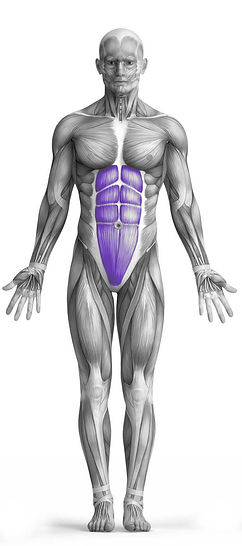Rope Crunch 101 Video Tutorial
0

Exercise Synopsis
Target Muscle Group
Abs
Execution
Compound
Force Type
Core
Required Equipment
Cable Machine
Fitness Level
Intermediate
Variations
Alternatives
Timer
Hour
Minute
Second
Stopwatch
00:00:00:00
Overview
The Rope Crunch is a highly effective exercise targeting the abdominal muscles, with a primary focus on the rectus abdominis. Utilizing a cable machine, this isolation movement involves flexing the spine to bring the ribcage towards the pelvis, providing a powerful contraction in the abs. While the rectus abdominis is the main target, the exercise also engages secondary muscles such as the obliques for stabilization and the forearms for grip strength. By incorporating the cable machine, constant tension is applied to the abs throughout the entire range of motion, making it an efficient exercise for building core strength and definition.
How to Perform
Begin by setting up a cable machine with a rope attachment at a high pulley setting. Kneel down facing away from the machine and grab the rope handles overhead with an overhand grip, ensuring they are level with your head.
Engage your core muscles and maintain a stable torso as you perform an inverted crunch motion by bending at the elbows and bringing them down towards your mid-thighs. Focus on contracting your abdominal muscles throughout the movement to maximize activation in the targeted abs.
Slowly return to the starting position by extending your arms overhead, maintaining control over the movement to resist the weight stack. Avoid swinging or using momentum to ensure that the abs are effectively engaged throughout the exercise.
Pay attention to your breathing pattern, exhaling as you crunch down and inhaling as you return to the starting position. This helps to stabilize your core and optimize muscle activation.
Additionally, maintain tension in your forearms throughout the exercise to improve grip strength and stability, as they act as secondary targets in the Rope Crunch.
★ Bonus: For exercises that involve external weights (such as dumbbells, barbells, or machines), the One Rep Max (1RM) calculator can help you estimate your maximum lifting capacity. Use it to track your strength progress and adjust your training for optimal results.
Tips
Rope crunch primarily targets the rectus abdominis, effectively engaging and strengthening the core muscles.
The exercise also activates the obliques, aiding in enhancing overall core stability and definition.
Utilizing a cable machine provides constant tension throughout the movement, maximizing muscle engagement and promoting muscle growth.
Rope crunches offer a versatile range of motion, allowing for effective contraction of the abdominal muscles from a fully stretched to fully contracted position.
The exercise helps in improving flexibility and mobility in the core region, facilitating better performance in various physical activities and reducing the risk of injuries.
Engaging the forearms as secondary muscles, rope crunches contribute to forearm strength and endurance, enhancing grip strength for other exercises and daily tasks.
Proper form is crucial to optimize the effectiveness of rope crunches and prevent strain or injury to the lower back.
Rope crunches can be easily adjusted to accommodate different fitness levels by adjusting the weight or the angle of pull on the cable machine.
Incorporating rope crunches into a comprehensive core workout routine can contribute to achieving a well-defined midsection and improved overall strength.
Regular inclusion of rope crunches in a workout regimen can lead to increased muscle endurance and functional strength, benefiting both athletic performance and everyday activities.
How Not to Perform
Avoid using excessive momentum: Control the movement throughout the exercise to prevent swinging or jerking, as this can diminish the effectiveness of targeting the abs and increase the risk of injury.
Do not arch the back excessively: Maintain a neutral spine position throughout the movement to prevent strain on the lower back and ensure proper engagement of the abdominal muscles.
Avoid pulling with the arms: Focus on using the abdominal muscles to initiate the movement rather than relying on the arms to pull the weight, as this can shift the emphasis away from the target muscles.
Do not round the shoulders forward: Keep the shoulders pulled back and down to maintain proper posture and ensure optimal engagement of the core muscles.
Avoid hyperextending the neck: Keep the neck in a neutral position by aligning it with the spine, avoiding excessive tilting or straining that can lead to neck discomfort or injury.
Do not grip the rope too tightly: Maintain a firm but relaxed grip on the rope to avoid unnecessary tension in the forearms and wrists, allowing the focus to remain on the abdominal muscles.
Avoid using too much weight: Select a resistance level that allows you to perform the exercise with proper form and control, avoiding the temptation to use excessive weight that could compromise technique and increase the risk of injury.
Do not hold your breath: Remember to breathe steadily throughout the movement, exhaling as you contract the abs and inhaling as you return to the starting position, to optimize oxygen flow and muscle engagement.
Avoid letting the weight stack slam down: Control the descent of the weight stack to prevent sudden jolts or impact on the muscles and joints, maintaining smooth and controlled movement throughout the exercise.
Do not neglect the mind-muscle connection: Focus on consciously contracting and squeezing the abdominal muscles with each repetition, rather than simply going through the motions, to maximize the effectiveness of the exercise and promote muscle growth and definition.
Variations
Variations of fitness exercises refer to different ways of performing a specific exercise or movement to target various muscle groups, intensities, or goals. These variations aim to challenge the body differently, prevent plateaus, and cater to individuals with varying fitness levels.
Alternatives
Alternative exercises in fitness refer to different movements or activities that target similar muscle groups or serve the same training purpose as the primary exercise. These alternative exercises can be used as substitutes when the original exercise is unavailable or challenging to perform due to various reasons such as equipment limitations, injuries, or personal preferences.








